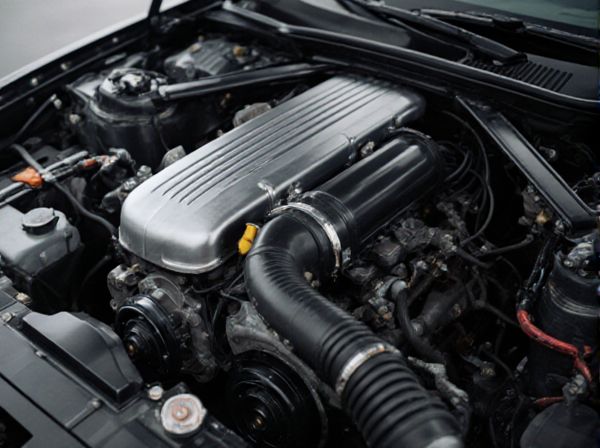
Photo illustration: Inline vs V Configuration
Inline engines feature cylinders arranged in a straight line, offering a compact and simpler design ideal for smooth power delivery and easy maintenance. V configuration engines position cylinders in two angled banks, enhancing engine balance and allowing for increased power output within a shorter length. Choosing between inline and V configuration depends on your priority for space efficiency, horsepower, and engine smoothness.
Table of Comparison
| Feature | Inline Engine | V Configuration Engine |
|---|---|---|
| Layout | Single straight row of cylinders | Two cylinder banks arranged in a 'V' shape |
| Engine Size | Typically 4 to 6 cylinders | Commonly 6 to 12 cylinders |
| Engine Length | Longer engine block | More compact lengthwise |
| Smoothness | Good vibration balance, especially in 6-cylinder | Smoother operation, better balance in V8 and above |
| Manufacturing | Simpler design, lower cost | Complex design, higher manufacturing cost |
| Engine Weight | Lighter overall | Heavier due to extra components |
| Performance | Efficient for mid-range power | Higher power output, suited for performance cars |
| Applications | Compact cars, sedans, small SUVs | Sports cars, luxury vehicles, trucks |
Introduction to Engine Configurations
Inline and V configurations represent two common engine layouts used in automotive design, impacting performance and packaging. An inline engine arranges cylinders in a single straight line, offering simplicity and smooth operation, while a V engine positions cylinders in two angled banks to reduce engine length and enhance power-to-weight ratio. Choosing between inline and V configurations involves considerations of vehicle size, balance, cooling efficiency, and desired performance characteristics.
What is an Inline Engine?
An inline engine, also known as a straight engine, features all cylinders arranged in a single row along the crankshaft, commonly found in 4-cylinder configurations due to its simplicity and compact design. This engine layout offers advantages such as smoother operation and easier maintenance compared to V engines, where cylinders are split into two banks at an angle. Inline engines are widely used in passenger cars for their efficiency and balanced performance, especially in smaller displacement vehicles.
What is a V Configuration Engine?
A V configuration engine features cylinders arranged in two angled banks forming a "V" shape, typically between 60 to 90 degrees, optimizing space and allowing for a more compact engine design compared to inline engines. This layout improves engine balance and reduces vibration due to the even firing order across both cylinder banks. V engines are widely used in performance and luxury vehicles because they offer a high power-to-weight ratio and better cooling efficiency.
Historical Evolution of Inline and V Engines
The historical evolution of inline and V engines reflects advancements in automotive engineering driven by performance and packaging needs. Inline engines, dominant in early automotive designs due to their simplicity and ease of manufacturing, were widely used in vehicles from the 1900s through mid-20th century. V engines emerged later, gaining popularity in the 1930s and beyond for their compact design and ability to deliver higher power outputs in luxury and high-performance cars.
Performance Comparison: Inline vs V Engines
Inline engines typically offer better fuel efficiency and smoother operation due to their simpler design and fewer moving parts, making them ideal for compact vehicles. V engines, with their staggered cylinder arrangement, generally provide higher power output and improved torque, suited for performance and luxury vehicles requiring greater acceleration and load capacity. Performance comparison shows inline engines excel in reliability and cost-effectiveness, while V engines dominate in power density and high-speed performance.
Space and Packaging Considerations
Inline engines feature a single row of cylinders aligned linearly, offering a narrower profile ideal for tight engine bays and compact vehicle designs. V-configuration engines, with two angled cylinder banks, occupy a wider footprint but allow for shorter engine length, providing better balance between longitudinal space and overall packaging. Space constraints in vehicles with limited engine compartment width often favor inline engines, while V configurations are chosen for applications requiring higher cylinder counts without excessively increasing engine length.
Fuel Efficiency and Emissions
Inline engines generally offer better fuel efficiency due to their simpler design and reduced internal friction compared to V configurations, which often results in lower fuel consumption. V engines, while typically delivering higher power output and smoother operation, tend to have higher emissions because of increased fuel usage and more complex exhaust management. Optimizing fuel injection systems and using advanced emission control technologies can mitigate emissions disparities between inline and V engine layouts.
Reliability and Maintenance Differences
Inline engines typically offer easier maintenance due to their simpler design with all cylinders aligned in a single row, facilitating straightforward access to components and fewer parts prone to failure. V configuration engines provide enhanced reliability under high-performance conditions by distributing mechanical loads more evenly across two cylinder banks, reducing stress on individual components. However, their complex architecture can lead to more challenging and time-consuming maintenance compared to inline engines.
Applications in Modern Vehicles
Inline engines offer compact design and smooth power delivery, making them ideal for smaller vehicles and everyday use in modern sedans and compact SUVs. V-configurations provide higher power output and better balance, favored in performance cars, luxury trucks, and SUVs requiring increased torque and speed. Both configurations play crucial roles in optimizing engine efficiency and vehicle dynamics across diverse automotive segments.
Choosing the Right Engine Configuration
Choosing the right engine configuration depends on factors such as vehicle size, performance needs, and efficiency. Inline engines offer a compact design with smooth power delivery, making them ideal for smaller cars and moderate power demands. V configurations provide higher power output and better balance for larger vehicles and high-performance applications, despite their increased complexity and weight.
 caratoz.com
caratoz.com